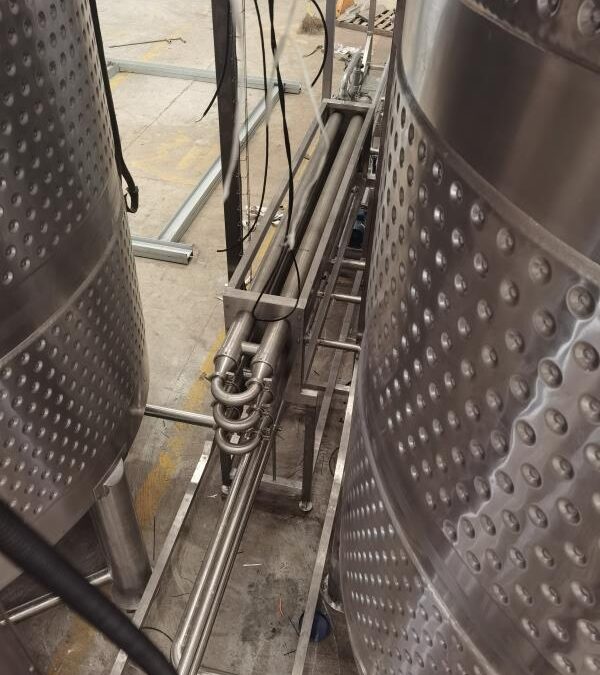The history of wine fermenter tanks dates back thousands of years, evolving alongside the development of winemaking techniques. Initially, the fermentation of grapes and other fruits into wine was a relatively simple process, often carried out in open containers or amphorae.
Ancient Winemaking:
In ancient times, winemaking was a common practice in various civilizations, including the Egyptians, Greeks, Romans, and Persians. These early winemakers used clay pots, amphorae, or large earthenware containers to ferment and store their wines. These vessels were typically buried in the ground or stored in cool, dark cellars to maintain a stable temperature during fermentation.
Wooden Barrels:
The use of wooden barrels for fermentation and storage began to gain popularity in ancient Rome. The Romans recognized the benefits of using wooden vessels, such as oak barrels, for winemaking. The wooden barrels allowed for controlled oxidation and aging of the wine while also providing a convenient way to transport and store the product. The use of wooden barrels continued throughout the Middle Ages and into the Renaissance, becoming a standard practice in winemaking.
Advancements in Modern Winemaking:
In the late 17th century, advancements in glassmaking led to the development of glass containers specifically designed for fermenting and storing wine. These glass vessels, known as demijohns, were sealed with corks to prevent oxygen from entering and to allow carbon dioxide to escape during fermentation.
However, it wasn’t until the 20th century that the modern wine fermenter tanks, as we know them today, began to emerge. The introduction of stainless steel as a material for winemaking equipment revolutionized the industry. Stainless steel tanks offered numerous advantages over other materials, such as ease of cleaning, temperature control, and prevention of unwanted chemical reactions with the wine.
Modern Fermenter Tanks:
With the rise of stainless steel tanks, winemakers gained better control over the fermentation process. These tanks are typically cylindrical in shape, with temperature control systems, and are available in various sizes to accommodate different winemaking volumes. Stainless steel tanks allow for precise temperature regulation during fermentation, which is crucial for maintaining the desired flavor and aroma profiles of the wine.
In recent years, additional advancements have been made in wine fermenter tank design and technology. For example, some tanks now feature automated systems for temperature control, agitation, and monitoring of various parameters such as pH and dissolved oxygen levels. These advancements help winemakers maintain consistency and quality across different vintages.
Furthermore, there has been a growing interest in alternative fermentation vessels, such as concrete tanks and oak fermenters. Concrete tanks are favored by some winemakers due to their ability to provide thermal stability and micro-oxygenation. Oak fermenters offer the added benefit of imparting desirable flavors and textures to the wine during fermentation.
The history of wine fermenter tanks has evolved from ancient clay pots and amphorae to wooden barrels and finally to modern stainless steel tanks. Each development has contributed to the improvement of winemaking techniques and the ability to create high-quality wines with consistent characteristics.
The Benefits Of A Dimpled With Agitation Wine Fermenter Tank
A dimpled wine fermenter tank with agitation offers several benefits in the winemaking process. Here are some advantages:
Enhanced Heat Transfer: The dimples on the surface of the tank create turbulence in the liquid during agitation, improving the heat transfer efficiency. This allows for better temperature control during fermentation. Efficient heat transfer helps to maintain a consistent fermentation temperature, which is crucial for achieving desired flavor profiles and preventing off-flavors or stuck fermentations.
Increased Oxygen Incorporation: Agitation in a dimpled tank helps to introduce oxygen into the wine during fermentation. Controlled oxygen exposure can be beneficial in certain winemaking styles, such as those that require the development of specific aromas and flavors through oxidative processes. Oxygenation can also contribute to color stability and the polymerization of tannins in red wines.
Homogeneous Mixing: Agitation in a dimpled tank ensures the uniform distribution of yeast, nutrients, and other additives throughout the fermentation vessel. This promotes a more consistent fermentation process and helps to avoid issues such as nutrient stratification or settling, which can negatively impact yeast health and fermentation kinetics.
Improved Yeast Health and Performance: Agitation helps to keep the yeast cells in suspension and prevent their settling at the bottom of the tank. This facilitates better access to nutrients, promotes yeast viability, and supports a healthy fermentation. Additionally, agitation helps to reduce the formation of temperature gradients, preventing stress on the yeast cells and improving their overall performance.
Better Extraction of Color and Flavor Compounds: The movement and contact between the wine and the grape skins or other solid materials during agitation can enhance the extraction of color pigments, tannins, and flavor compounds. This can be particularly beneficial for red wine production, where optimal extraction is desired for achieving desired color intensity, structure, and complexity.
Easier Cleaning and Maintenance: Dimpled tanks are designed for efficient cleaning. The dimples facilitate the flow of cleaning agents and rinse water, allowing for more effective removal of residues and ensuring the tank’s hygiene. Additionally, the agitation process can help dislodge any deposits or sediment that may have settled at the bottom of the tank, further facilitating cleaning and maintenance.
Overall, a dimpled wine fermenter tank with agitation provides winemakers with improved control over the fermentation process, enhanced heat transfer, and better mixing. These benefits contribute to the production of high-quality wines with desired flavor profiles, optimal extraction, and improved yeast performance.
How Dimpled With Agitation Wine Fermenter Tanks Can Increase Abv
Dimpled with agitation wine fermenter tanks do not directly increase the alcohol by volume (ABV) of wine. The primary factor determining the ABV is the sugar content in the grapes or juice at the beginning of fermentation. During fermentation, yeast consumes the sugar and converts it into alcohol and carbon dioxide through the process of alcoholic fermentation.
However, dimpled with agitation wine fermenter tanks can indirectly contribute to maximizing ABV in the following ways:
Improved Yeast Activity: Agitation helps to keep the yeast cells in suspension and promotes better access to nutrients, including sugars, for fermentation. This can enhance yeast activity and ensure a more complete fermentation. Efficient fermentation with active yeast will consume a higher percentage of the available sugar, potentially resulting in a higher ABV.
Enhanced Yeast Health and Viability: Agitation in the tank can help prevent settling of yeast cells and ensure their consistent contact with the fermenting liquid. This promotes yeast health, viability, and overall fermentation performance. Healthy yeast populations are more efficient at fermenting sugars, which can lead to a more complete fermentation and higher ABV.
Better Nutrient Distribution: Agitation in the tank facilitates the uniform distribution of nutrients throughout the fermentation vessel. Yeast require various nutrients, such as nitrogen, vitamins, and minerals, for optimal growth and fermentation. Proper nutrient availability supports healthy yeast metabolism, leading to more efficient sugar consumption and potentially higher ABV.
It’s important to note that while dimpled with agitation tanks can contribute to optimal fermentation conditions, the final ABV is also influenced by other factors such as grape variety, sugar content, yeast strain, fermentation temperature, and fermentation time. Achieving a desired ABV requires careful management of these variables in addition to the use of appropriate fermentation equipment.

